Answered step by step
Verified Expert Solution
Question
1 Approved Answer
answer question 2 What is an initial public offering (IPO), and why does IPO attract so much attention Is it appropriate for Medibank to pursue
answer question 2 
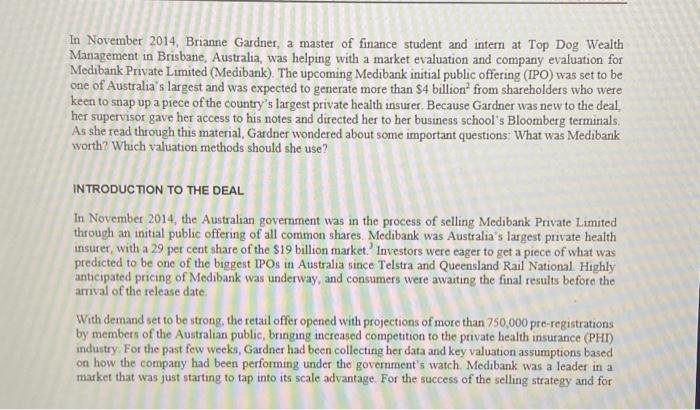
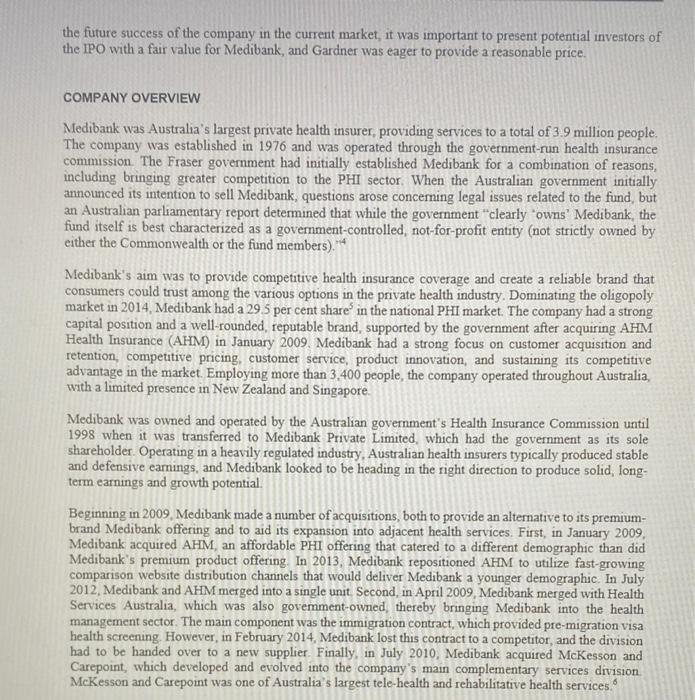
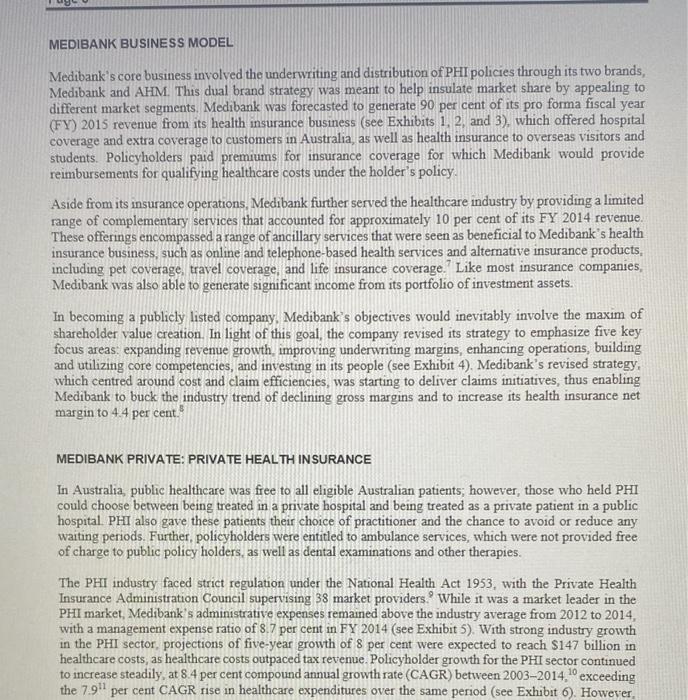
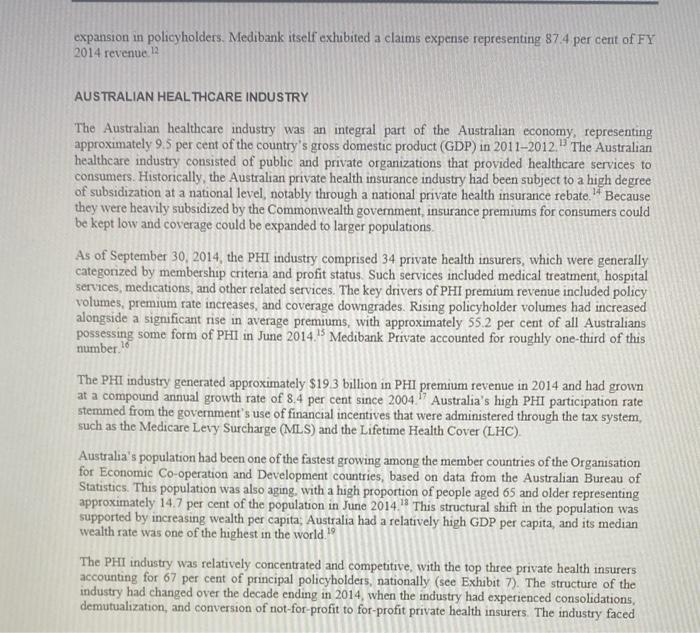
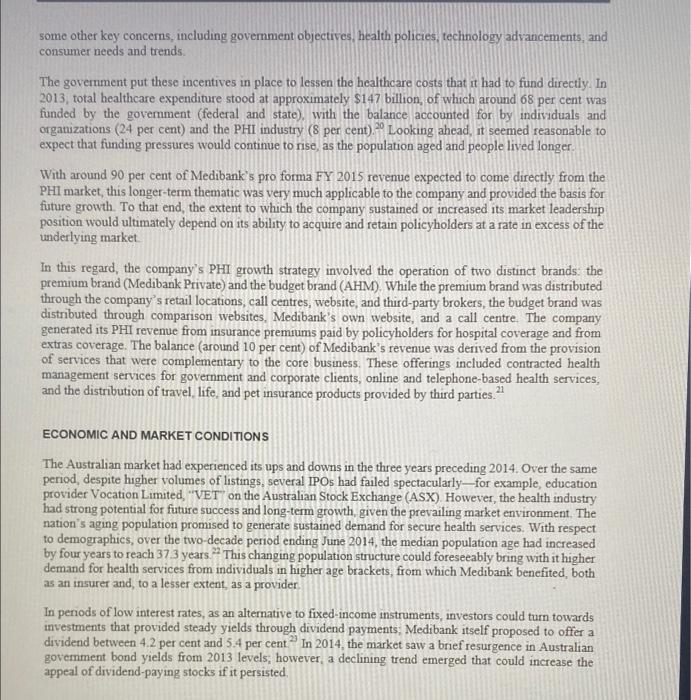
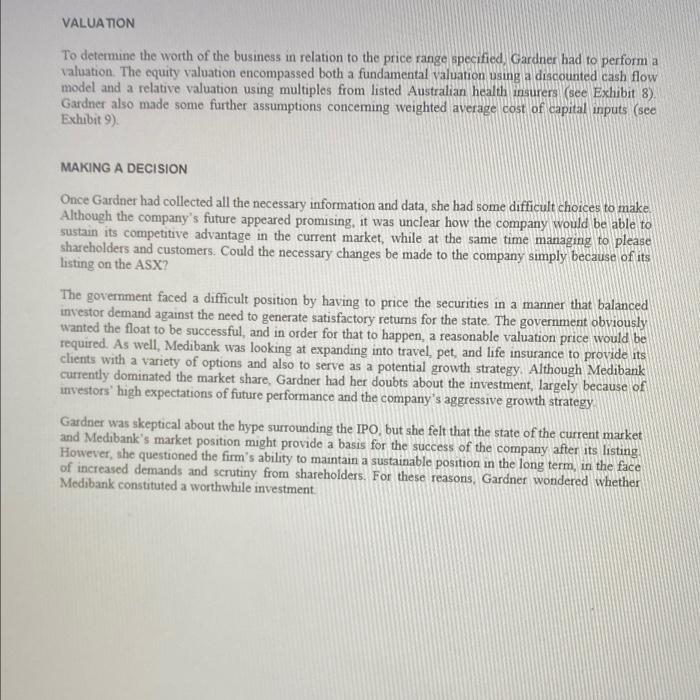
What is an initial public offering (IPO), and why does IPO attract so much attention Is it appropriate for Medibank to pursue this form of capital raising (i.e. IPO)? In November 2014, Brianne Gardner, a master of finance student and intern at Top Dog Wealth Management in Brisbane, Australia, was helping with a market evaluation and company evaluation for Medibank Private Limited (Medibank). The upcoming Medibank initial public offering (IPO) was set to be one of Australia's largest and was expected to generate more than $4 billion from shareholders who were keen to snap up a piece of the country's largest private health insurer. Because Gardner was new to the deal. her supervisor gave her access to his notes and directed her to her business school's Bloomberg terminals, As she read through this material, Gardner wondered about some important questions: What was Medibank worth? Which valuation methods should she use? INTRODUCTION TO THE DEAL In November 2014, the Australian government was in the process of selling Medibank Private Limited through an initial public offering of all common shares Medibank was Australia's largest private health insurer with a 29 per cent share of the $19 billion market. Investors were eager to get a piece of what was predicted to be one of the biggest IPOs in Australia since Telstra and Queensland Rail National. Highly anticipated pricing of Medibank was underway, and consumers were awaiting the final results before the arrival of the release date With demand set to be strong, the retail offer opened with projections of more than 250,000 pre-registrations by members of the Australian public, bringing increased competition to the private health insurance (PHI) industry. For the past few weeks, Gardner had been collecting her data and key valuation assumptions based on how the company had been performing under the government's watch Medibank was a leader in a market that was just starting to tap into its scale advantage. For the success of the selling strategy and for the future success of the company in the current market, it was important to present potential investors of the IPO with a fair value for Medibank, and Gardner was eager to provide a reasonable price. COMPANY OVERVIEW Medibank was Australia's largest private health insurer, providing services to a total of 3.9 million people. The company was established in 1976 and was operated through the government-run health insurance commission. The Fraser government had initially established Medibank for a combination of reasons, including bringing greater competition to the PHI sector. When the Australian government initially announced its intention to sell Medibank, questions arose concerning legal issues related to the fund, but an Australian parliamentary report determined that while the government clearly 'owns' Medibank, the fund itself is best characterized as a government-controlled, not-for-profit entity (not strictly owned by either the Commonwealth or the fund members)." Medibank's aim was to provide competitive health insurance coverage and create a reliable brand that consumers could trust among the various options in the private health industry. Dominating the oligopoly market in 2014, Medibank had a 29.5 per cent share in the national PHI market. The company had a strong capital position and a well-rounded reputable brand, supported by the government after acquiring AHM Health Insurance (AHM) in January 2009. Medibank had a strong focus on customer acquisition and retention, competitive pricing, customer service, product innovation, and sustaining its competitive advantage in the market. Employing more than 3.400 people, the company operated throughout Australia, with a limited presence in New Zealand and Singapore Medibank was owned and operated by the Australian government's Health Insurance Commission until 1998 when it was transferred to Medibank Private Limited, which had the government as its sole shareholder. Operating in a heavily regulated industry, Australian health insurers typically produced stable and defensive earnings, and Medibarik looked to be heading in the right direction to produce solid, long- term earnings and growth potential. Beginning in 2009 Medibank made a number of acquisitions, both to provide an alternative to its premium- brand Medibank offering and to aid its expansion into adjacent health services. First, in January 2009, Medibank acquired AHM, an affordable PHI offering that catered to a different demographic than did Medibank's premium product offering. In 2013, Medibank repositioned AHM to utilize fast-growing comparison website distribution channels that would deliver Medibank a younger demographic. In July 2012, Medibank and AHM merged into a single unit. Second, in April 2009, Medibank merged with Health Services Australia, which was also govemment-owned, thereby bringing Medibank into the health management sector. The main component was the immigration contract, which provided pre-migration visa health screening. However, in February 2014, Medibank lost this contract to a competitor, and the division had to be handed over to a new supplier. Finally, in July 2010, Medibank acquired McKesson and Carepoint, which developed and evolved into the company's main complementary services division McKesson and Carepoint was one of Australia's largest tele-health and rehabilitative health services. MEDIBANK BUSINESS MODEL Medibank's core business involved the underwriting and distribution of PHI policies through its two brands, Medibank and AHM. This dual brand strategy was meant to help insulate market share by appealing to different market segments. Medibank was forecasted to generate 90 per cent of its pro forma fiscal year (FY) 2015 revenue from its health insurance business (see Exhibits 1, 2, and 3), which offered hospital coverage and extra coverage to customers in Australia, as well as health insurance to overseas visitors and students. Policyholders paid premiums for insurance coverage for which Medibank would provide reimbursements for qualifying healthcare costs under the holder's policy. Aside from its insurance operations, Medibank further served the healthcare industry by providing a limited range of complementary services that accounted for approximately 10 per cent of its FY 2014 revenue. These offerings encompassed a range of ancillary services that were seen as beneficial to Medibank's health insurance business, such as online and telephone-based health services and alternative insurance products, including pet coverage, travel coverage, and life insurance coverage. Like most insurance companies, Medibank was also able to generate significant income from its portfolio of investment assets. In becoming a publicly listed company. Medibank's objectives would inevitably involve the maxim of shareholder value creation. In light of this goal, the company revised its strategy to emphasize five key focus areas: expanding revenue growth, improving underwriting margins, enhancing operations, building and utilizing core competencies, and investing in its people (see Exhibit 4). Medibank's revised strategy, which centred around cost and claim efficiencies, was starting to deliver claims initiatives, thus enabling Medibank to buck the industry trend of declining gross margins and to increase its health insurance net margin to 4.4 per cent. MEDIBANK PRIVATE: PRIVATE HEALTH INSURANCE In Australia, public healthcare was free to all eligible Australian patients; however, those who held PHI could choose between being treated in a private hospital and being treated as a private patient in a public hospital. PHI also gave these patients their choice of practitioner and the chance to avoid or reduce any waiting periods. Further, policyholders were entitled to ambulance services, which were not provided free of charge to public policy holders, as well as dental examinations and other therapies. The PHI industry faced strict regulation under the National Health Act 1953, with the Private Health Insurance Administration Council supervising 38 market providers. While it was a market leader in the PHI market, Medibank's administrative expenses remained above the industry average from 2012 to 2014, with a management expense ratio of 8.7 per cent in FY 2014 (see Exhibit 5). With strong industry growth in the PHI sector projections of five-year growth of 8 per cent were expected to reach $147 billion in healthcare costs, as healthcare costs outpaced tax revenue Policyholder growth for the PHI sector continued to increase steadily, at 8.4 per cent compound annual growth rate (CAGR) between 2003-2014. exceeding the 7.911 per cent CAGR rise in healthcare expenditures over the same period (see Exhibit 6). However, 10 expansion in policyholders. Medibank itself exhibited a claims expense representing 87.4 per cent of FY 2014 revenue 12 AUSTRALIAN HEALTHCARE INDUSTRY The Australian healthcare industry was an integral part of the Australian economy, representing approximately 9.5 per cent of the country's gross domestic product (GDP) in 2011-2012. The Australian healthcare industry consisted of public and private organizations that provided healthcare services to consumers. Historically, the Australian private health insurance industry had been subject to a high degree of subsidization at a national level, notably through a national private health insurance rebate. Because they were heavily subsidized by the Commonwealth government insurance premiums for consumers could be kept low and coverage could be expanded to larger populations As of September 30, 2014, the PHI industry comprised 34 private health insurers, which were generally categorized by membership criteria and profit status. Such services included medical treatment, hospital services, medications, and other related services. The key drivers of PHI premium revenue included policy volumes, premium rate increases, and coverage downgrades. Rising policyholder volumes had increased alongside a significant rise in average premiums, with approximately 55.2 per cent of all Australians possessing some form of PHI in June 2014.Medibank Private accounted for roughly one-third of this number 1 The PHI industry generated approximately $193 billion in PHI premium revenue in 2014 and had grown at a compound annual growth rate of 8.4 per cent since 2004.? Australia's high PHI participation rate stemmed from the government's use of financial incentives that were administered through the tax system, such as the Medicare Levy Surcharge (MLS) and the Lifetime Health Cover (LHC) Australia's population had been one of the fastest growing among the member countries of the Organisation for Economic Co-operation and Development countries, based on data from the Australian Bureau of Statistics. This population was also aging, with a high proportion of people aged 65 and older representing approximately 14.7 per cent of the population in June 2014.18 This structural shift in the population was supported by increasing wealth per capita; Australia had a relatively high GDP per capita, and its median wealth rate was one of the highest in the world." The PHI industry was relatively concentrated and competitive, with the top three private health insurers accounting for 67 per cent of principal policyholders, nationally (see Exhibit 7). The structure of the industry had changed over the decade ending in 2014, when the industry had experienced consolidations, demutualization, and conversion of not-for-profit to for-profit private health insurers. The industry faced some other key concerns, including government objectives, health policies, technology advancements, and consumer needs and trends. The government put these incentives in place to lessen the healthcare costs that it had to fund directly. In 2013, total healthcare expenditure stood at approximately $147 billion, of which around 68 per cent was funded by the government (federal and state), with the balance accounted for by individuals and organizations (24 per cent) and the PHI industry (8 per cent). Looking ahead, it seemed reasonable to expect that funding pressures would continue to rise, as the population aged and people lived longer With around 90 per cent of Medibank's pro forma FY 2015 revenue expected to come directly from the PHI market this longer-term thematic was very much applicable to the company and provided the basis for future growth. To that end, the extent to which the company sustained or increased its market leadership position would ultimately depend on its ability to acquire and retain policyholders at a rate in excess of the underlying market In this regard, the company's PHI growth strategy involved the operation of two distinct brands: the premium brand (Medibank Private) and the budget brand (AHM) While the premium brand was distributed through the company's retail locations, call centres, website, and third-party brokers, the budget brand was distributed through comparison websites, Medibank's own website, and a call centre. The company generated its PHI revenue from insurance premiums paid by policyholders for hospital coverage and from extras coverage. The balance (around 10 per cent) of Medibank's revenue was derived from the provision of services that were complementary to the core business. These offerings included contracted health management services for government and corporate clients, online and telephone-based health services, and the distribution of travel, life, and pet insurance products provided by third parties. 21 ECONOMIC AND MARKET CONDITIONS The Australian market had experienced its ups and downs in the three years preceding 2014. Over the same period, despite higher volumes of listings, several IPOs had failed spectacularly-for example, education provider Vocation Limited, "VET" on the Australian Stock Exchange (ASX) However, the health industry had strong potential for future success and long-term growth, given the prevailing market environment. The nation's aging population promised to generate sustained demand for secure health services. With respect to demographics, over the two decade period ending June 2014, the median population age had increased by four years to reach 373 years. This changing population structure could foreseeably bring with it higher demand for health services from individuals in higher age brackets, from which Medibank benefited, both as an insurer and, to a lesser extent, as a provider In periods of low interest rates, as an alternative to fixed-income instruments, investors could turn towards investments that provided steady yields through dividend payments: Medibank itself proposed to offer a dividend between 4.2 per cent and 5.4 per cent In 2014, the market saw a brief resurgence in Australian government bond yields from 2013 levels; however, a declining trend emerged that could increase the appeal of dividend paying stocks if it persisted, VALUATION To determine the worth of the business in relation to the price range specified Gardner had to perform a valuation. The equity valuation encompassed both a fundamental valuation using a discounted cash flow model and a relative valuation using multiples from listed Australian health insurers (see Exhibit 8) Gardner also made some further assumptions conceming weighted average cost of capital inputs (see Exhibit 9) MAKING A DECISION Once Gardner had collected all the necessary information and data, she had some difficult choices to make. Although the company's future appeared promising, it was unclear how the company would be able to sustain its competitive advantage in the current market, while at the same time managing to please shareholders and customers. Could the necessary changes be made to the company simply because of its Listing on the ASX? The government faced a difficult position by having to price the securities in a manner that balanced investor demand against the need to generate satisfactory returns for the state. The government obviously wanted the float to be successful and in order for that to happen, a reasonable valuation price would be required. As well, Medibank was looking at expanding into travel, pet, and life insurance to provide its clients with a variety of options and also to serve as a potential growth strategy. Although Medibank currently dominated the market share, Gardner had her doubts about the investment, largely because of investors' high expectations of future performance and the company's aggressive growth strategy Gardner was skeptical about the hype surrounding the IPO, but she felt that the state of the current market and Medibank's market position might provide a basis for the success of the company after its listing However, she questioned the firm's ability to maintain a sustainable position in the long term, in the face of increased demands and scrutiny from shareholders. For these reasons, Gardner wondered whether Medibank constituted a worthwhile investment What is an initial public offering (IPO), and why does IPO attract so much attention Is it appropriate for Medibank to pursue this form of capital raising (i.e. IPO)? In November 2014, Brianne Gardner, a master of finance student and intern at Top Dog Wealth Management in Brisbane, Australia, was helping with a market evaluation and company evaluation for Medibank Private Limited (Medibank). The upcoming Medibank initial public offering (IPO) was set to be one of Australia's largest and was expected to generate more than $4 billion from shareholders who were keen to snap up a piece of the country's largest private health insurer. Because Gardner was new to the deal. her supervisor gave her access to his notes and directed her to her business school's Bloomberg terminals, As she read through this material, Gardner wondered about some important questions: What was Medibank worth? Which valuation methods should she use? INTRODUCTION TO THE DEAL In November 2014, the Australian government was in the process of selling Medibank Private Limited through an initial public offering of all common shares Medibank was Australia's largest private health insurer with a 29 per cent share of the $19 billion market. Investors were eager to get a piece of what was predicted to be one of the biggest IPOs in Australia since Telstra and Queensland Rail National. Highly anticipated pricing of Medibank was underway, and consumers were awaiting the final results before the arrival of the release date With demand set to be strong, the retail offer opened with projections of more than 250,000 pre-registrations by members of the Australian public, bringing increased competition to the private health insurance (PHI) industry. For the past few weeks, Gardner had been collecting her data and key valuation assumptions based on how the company had been performing under the government's watch Medibank was a leader in a market that was just starting to tap into its scale advantage. For the success of the selling strategy and for the future success of the company in the current market, it was important to present potential investors of the IPO with a fair value for Medibank, and Gardner was eager to provide a reasonable price. COMPANY OVERVIEW Medibank was Australia's largest private health insurer, providing services to a total of 3.9 million people. The company was established in 1976 and was operated through the government-run health insurance commission. The Fraser government had initially established Medibank for a combination of reasons, including bringing greater competition to the PHI sector. When the Australian government initially announced its intention to sell Medibank, questions arose concerning legal issues related to the fund, but an Australian parliamentary report determined that while the government clearly 'owns' Medibank, the fund itself is best characterized as a government-controlled, not-for-profit entity (not strictly owned by either the Commonwealth or the fund members)." Medibank's aim was to provide competitive health insurance coverage and create a reliable brand that consumers could trust among the various options in the private health industry. Dominating the oligopoly market in 2014, Medibank had a 29.5 per cent share in the national PHI market. The company had a strong capital position and a well-rounded reputable brand, supported by the government after acquiring AHM Health Insurance (AHM) in January 2009. Medibank had a strong focus on customer acquisition and retention, competitive pricing, customer service, product innovation, and sustaining its competitive advantage in the market. Employing more than 3.400 people, the company operated throughout Australia, with a limited presence in New Zealand and Singapore Medibank was owned and operated by the Australian government's Health Insurance Commission until 1998 when it was transferred to Medibank Private Limited, which had the government as its sole shareholder. Operating in a heavily regulated industry, Australian health insurers typically produced stable and defensive earnings, and Medibarik looked to be heading in the right direction to produce solid, long- term earnings and growth potential. Beginning in 2009 Medibank made a number of acquisitions, both to provide an alternative to its premium- brand Medibank offering and to aid its expansion into adjacent health services. First, in January 2009, Medibank acquired AHM, an affordable PHI offering that catered to a different demographic than did Medibank's premium product offering. In 2013, Medibank repositioned AHM to utilize fast-growing comparison website distribution channels that would deliver Medibank a younger demographic. In July 2012, Medibank and AHM merged into a single unit. Second, in April 2009, Medibank merged with Health Services Australia, which was also govemment-owned, thereby bringing Medibank into the health management sector. The main component was the immigration contract, which provided pre-migration visa health screening. However, in February 2014, Medibank lost this contract to a competitor, and the division had to be handed over to a new supplier. Finally, in July 2010, Medibank acquired McKesson and Carepoint, which developed and evolved into the company's main complementary services division McKesson and Carepoint was one of Australia's largest tele-health and rehabilitative health services. MEDIBANK BUSINESS MODEL Medibank's core business involved the underwriting and distribution of PHI policies through its two brands, Medibank and AHM. This dual brand strategy was meant to help insulate market share by appealing to different market segments. Medibank was forecasted to generate 90 per cent of its pro forma fiscal year (FY) 2015 revenue from its health insurance business (see Exhibits 1, 2, and 3), which offered hospital coverage and extra coverage to customers in Australia, as well as health insurance to overseas visitors and students. Policyholders paid premiums for insurance coverage for which Medibank would provide reimbursements for qualifying healthcare costs under the holder's policy. Aside from its insurance operations, Medibank further served the healthcare industry by providing a limited range of complementary services that accounted for approximately 10 per cent of its FY 2014 revenue. These offerings encompassed a range of ancillary services that were seen as beneficial to Medibank's health insurance business, such as online and telephone-based health services and alternative insurance products, including pet coverage, travel coverage, and life insurance coverage. Like most insurance companies, Medibank was also able to generate significant income from its portfolio of investment assets. In becoming a publicly listed company. Medibank's objectives would inevitably involve the maxim of shareholder value creation. In light of this goal, the company revised its strategy to emphasize five key focus areas: expanding revenue growth, improving underwriting margins, enhancing operations, building and utilizing core competencies, and investing in its people (see Exhibit 4). Medibank's revised strategy, which centred around cost and claim efficiencies, was starting to deliver claims initiatives, thus enabling Medibank to buck the industry trend of declining gross margins and to increase its health insurance net margin to 4.4 per cent. MEDIBANK PRIVATE: PRIVATE HEALTH INSURANCE In Australia, public healthcare was free to all eligible Australian patients; however, those who held PHI could choose between being treated in a private hospital and being treated as a private patient in a public hospital. PHI also gave these patients their choice of practitioner and the chance to avoid or reduce any waiting periods. Further, policyholders were entitled to ambulance services, which were not provided free of charge to public policy holders, as well as dental examinations and other therapies. The PHI industry faced strict regulation under the National Health Act 1953, with the Private Health Insurance Administration Council supervising 38 market providers. While it was a market leader in the PHI market, Medibank's administrative expenses remained above the industry average from 2012 to 2014, with a management expense ratio of 8.7 per cent in FY 2014 (see Exhibit 5). With strong industry growth in the PHI sector projections of five-year growth of 8 per cent were expected to reach $147 billion in healthcare costs, as healthcare costs outpaced tax revenue Policyholder growth for the PHI sector continued to increase steadily, at 8.4 per cent compound annual growth rate (CAGR) between 2003-2014. exceeding the 7.911 per cent CAGR rise in healthcare expenditures over the same period (see Exhibit 6). However, 10 expansion in policyholders. Medibank itself exhibited a claims expense representing 87.4 per cent of FY 2014 revenue 12 AUSTRALIAN HEALTHCARE INDUSTRY The Australian healthcare industry was an integral part of the Australian economy, representing approximately 9.5 per cent of the country's gross domestic product (GDP) in 2011-2012. The Australian healthcare industry consisted of public and private organizations that provided healthcare services to consumers. Historically, the Australian private health insurance industry had been subject to a high degree of subsidization at a national level, notably through a national private health insurance rebate. Because they were heavily subsidized by the Commonwealth government insurance premiums for consumers could be kept low and coverage could be expanded to larger populations As of September 30, 2014, the PHI industry comprised 34 private health insurers, which were generally categorized by membership criteria and profit status. Such services included medical treatment, hospital services, medications, and other related services. The key drivers of PHI premium revenue included policy volumes, premium rate increases, and coverage downgrades. Rising policyholder volumes had increased alongside a significant rise in average premiums, with approximately 55.2 per cent of all Australians possessing some form of PHI in June 2014.Medibank Private accounted for roughly one-third of this number 1 The PHI industry generated approximately $193 billion in PHI premium revenue in 2014 and had grown at a compound annual growth rate of 8.4 per cent since 2004.? Australia's high PHI participation rate stemmed from the government's use of financial incentives that were administered through the tax system, such as the Medicare Levy Surcharge (MLS) and the Lifetime Health Cover (LHC) Australia's population had been one of the fastest growing among the member countries of the Organisation for Economic Co-operation and Development countries, based on data from the Australian Bureau of Statistics. This population was also aging, with a high proportion of people aged 65 and older representing approximately 14.7 per cent of the population in June 2014.18 This structural shift in the population was supported by increasing wealth per capita; Australia had a relatively high GDP per capita, and its median wealth rate was one of the highest in the world." The PHI industry was relatively concentrated and competitive, with the top three private health insurers accounting for 67 per cent of principal policyholders, nationally (see Exhibit 7). The structure of the industry had changed over the decade ending in 2014, when the industry had experienced consolidations, demutualization, and conversion of not-for-profit to for-profit private health insurers. The industry faced some other key concerns, including government objectives, health policies, technology advancements, and consumer needs and trends. The government put these incentives in place to lessen the healthcare costs that it had to fund directly. In 2013, total healthcare expenditure stood at approximately $147 billion, of which around 68 per cent was funded by the government (federal and state), with the balance accounted for by individuals and organizations (24 per cent) and the PHI industry (8 per cent). Looking ahead, it seemed reasonable to expect that funding pressures would continue to rise, as the population aged and people lived longer With around 90 per cent of Medibank's pro forma FY 2015 revenue expected to come directly from the PHI market this longer-term thematic was very much applicable to the company and provided the basis for future growth. To that end, the extent to which the company sustained or increased its market leadership position would ultimately depend on its ability to acquire and retain policyholders at a rate in excess of the underlying market In this regard, the company's PHI growth strategy involved the operation of two distinct brands: the premium brand (Medibank Private) and the budget brand (AHM) While the premium brand was distributed through the company's retail locations, call centres, website, and third-party brokers, the budget brand was distributed through comparison websites, Medibank's own website, and a call centre. The company generated its PHI revenue from insurance premiums paid by policyholders for hospital coverage and from extras coverage. The balance (around 10 per cent) of Medibank's revenue was derived from the provision of services that were complementary to the core business. These offerings included contracted health management services for government and corporate clients, online and telephone-based health services, and the distribution of travel, life, and pet insurance products provided by third parties. 21 ECONOMIC AND MARKET CONDITIONS The Australian market had experienced its ups and downs in the three years preceding 2014. Over the same period, despite higher volumes of listings, several IPOs had failed spectacularly-for example, education provider Vocation Limited, "VET" on the Australian Stock Exchange (ASX) However, the health industry had strong potential for future success and long-term growth, given the prevailing market environment. The nation's aging population promised to generate sustained demand for secure health services. With respect to demographics, over the two decade period ending June 2014, the median population age had increased by four years to reach 373 years. This changing population structure could foreseeably bring with it higher demand for health services from individuals in higher age brackets, from which Medibank benefited, both as an insurer and, to a lesser extent, as a provider In periods of low interest rates, as an alternative to fixed-income instruments, investors could turn towards investments that provided steady yields through dividend payments: Medibank itself proposed to offer a dividend between 4.2 per cent and 5.4 per cent In 2014, the market saw a brief resurgence in Australian government bond yields from 2013 levels; however, a declining trend emerged that could increase the appeal of dividend paying stocks if it persisted, VALUATION To determine the worth of the business in relation to the price range specified Gardner had to perform a valuation. The equity valuation encompassed both a fundamental valuation using a discounted cash flow model and a relative valuation using multiples from listed Australian health insurers (see Exhibit 8) Gardner also made some further assumptions conceming weighted average cost of capital inputs (see Exhibit 9) MAKING A DECISION Once Gardner had collected all the necessary information and data, she had some difficult choices to make. Although the company's future appeared promising, it was unclear how the company would be able to sustain its competitive advantage in the current market, while at the same time managing to please shareholders and customers. Could the necessary changes be made to the company simply because of its Listing on the ASX? The government faced a difficult position by having to price the securities in a manner that balanced investor demand against the need to generate satisfactory returns for the state. The government obviously wanted the float to be successful and in order for that to happen, a reasonable valuation price would be required. As well, Medibank was looking at expanding into travel, pet, and life insurance to provide its clients with a variety of options and also to serve as a potential growth strategy. Although Medibank currently dominated the market share, Gardner had her doubts about the investment, largely because of investors' high expectations of future performance and the company's aggressive growth strategy Gardner was skeptical about the hype surrounding the IPO, but she felt that the state of the current market and Medibank's market position might provide a basis for the success of the company after its listing However, she questioned the firm's ability to maintain a sustainable position in the long term, in the face of increased demands and scrutiny from shareholders. For these reasons, Gardner wondered whether Medibank constituted a worthwhile investment 






Step by Step Solution
There are 3 Steps involved in it
Step: 1

Get Instant Access to Expert-Tailored Solutions
See step-by-step solutions with expert insights and AI powered tools for academic success
Step: 2

Step: 3

Ace Your Homework with AI
Get the answers you need in no time with our AI-driven, step-by-step assistance
Get Started


